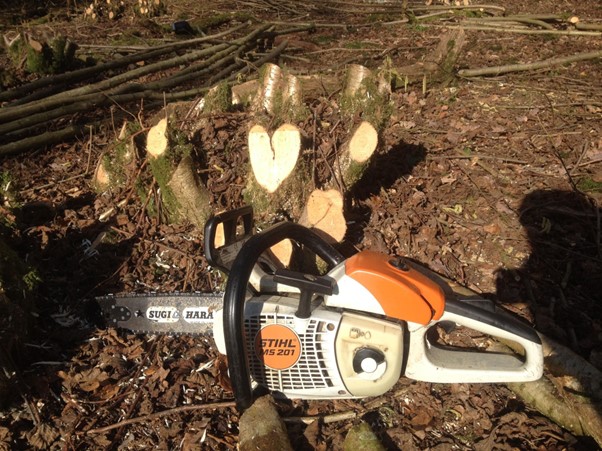 Tom Pattinson is a Woodland Officer for the Forestry Commission based in the North West and West Midlands Area. In this post he explains the fundamentals of coppicing, a woodland management practice dating back to the Stone Age, and the opportunities for its use within our native woodlands.
Tom Pattinson is a Woodland Officer for the Forestry Commission based in the North West and West Midlands Area. In this post he explains the fundamentals of coppicing, a woodland management practice dating back to the Stone Age, and the opportunities for its use within our native woodlands.
What is coppicing?
Coppicing is the process of cutting a tree close to the ground in the autumn and winter to encourage the production of shoots from the base of the tree, this forms what is known as a stool. These shoots grow rapidly and produce a crop consisting of many stems which are typically ready for harvesting after 7-20 years, depending on the desired product. This can be done with most British hardwoods, with hazel, willow, sweet chestnut and oak being good species.

Stools coppiced in the same year in the same area can be grouped together to form a coupe. Several coupes can then be combined within a woodland to form a coppice. For example, a hazel coppice on an eight-year rotation could be separated into eight equally sized coups to provide a steady production of hedging stakes.

Why Coppice?
Coppicing can provide a variety of ecological and economic benefits.
Ecological benefits
Coppicing emulates the natural formation of semi-open glades and creates a permanent early successional habitat, which includes a mix of light demanding annuals, grasses and shrubs. It also provides several micro habitats (open, semi-open and closed canopy) which benefit a wide range of species in a small geographical area. This is particularly useful for light demanding ground plants.
As the site is coppiced repeatedly there is a permanence of the open and semi-open wooded habitats, this allows for low mobility species such as high brown fritillary butterflies to colonise and flourish on the site.

Economic benefits
Coppicing provides a regular crop of products on a relatively short rotation when compared to conventional timber, for example 10 years vs 60 years. The coppice regrowth provides a continuous crop for harvesting without the need to replant.
Coppicing also provides products to a range of traditional crafts including hedge layers, thatchers and basket makers.

The coppicing checklist
Confirm if your woodland is suitable for coppicing
- If your woodland is a historical coppice site, it may still be suitable for coppicing. Look for old multi-stemmed trees (especially oak, sweet chestnut or lime), or woodlands with a large amount of hazel understorey underneath larger trees such as oak. It’s never too late to restore a coppice, even after decades of neglect.
- If you have trees or shrubs adjacent to rides and open space within the woodland, then coppice could be incorporated into ride management to allow more light into the ride, which then encourages biodiversity.
- Woodlands where open wooded habitat is wanted, for example to benefit wildlife, could be suitable for coppicing and it could help to offset your costs.
Make sure there is enough light
Coppice stools require a high amount of light to allow for sufficient regrowth.
- Reduce the large tree canopy to allow adequate light to the coppiced stools. Retain veteran and future veteran trees, or good future timber trees.
- Have sufficiently sized coupes to limit edge shading from the surrounding taller coupes/high forest.
Protect your woodland from deer
- Protection from deer browsing is needed as it’s especially detrimental to coppice since it’s within the deer browse level for most of its growing cycle.
- Deer damage causes the forking of products when the stem tips are eaten which lowers their value, while antler rubbing causes defects at the bottom of mature stems and repeated browsing can even kill stools.
- Deer population numbers need to be controlled, and/or excluded using deer fencing.
Seek expert advice
- The National Coppice Federation is an organisation with members across the UK, many of whom are looking to coppice more woodlands or can provide advice, contact your local National Coppice Federation Group.
- If you’re in the South West, North East or East Midlands there’s a coppice mapping project where you can get free advice on how to manage your coppiced woodland and help get coppicing back on the map.
- Contact your local Forestry Commission Woodland Officer for any woodland management advice.
Manage your expectations
Coppicing is a way to manage your woodland and it can pay for itself, but you need to be aware that:
- The first cut (restoration cut) of a neglected coppice usually only provides firewood.
- There is money to be made from end wood products, but they require a good number of people hours to produce.
How can the Forestry Commission help?
We can help you develop a woodland management plan to better inform management decisions in your woodland.
With a woodland management plan, you could be eligible for the Countryside Stewardship Higher Tier funding, where there is a grant for coppice restoration, and capital grants for deer fencing and deer control.
You can also apply for felling licences which will likely be needed for coppice restoration.
I’d like to thank members of the National Coppice Federation and others for sharing their photos with us.
For more information and resources about woodland management, visit our Woodland Management Matters webpage.



4 comments
Comment by Robin Gray posted on
Great blog Tom. We should all be alive to introducing coppice elements into woodland creation schemes when the option and will is there.
Comment by John Pemberton posted on
The article talks about deer browsing damaging coppice as it regrows, and suggests fencing. Fencing is often prohibitively expensive, but there is another solution which should be mentioned. It is to pollard the tree; to cut the stems at say, 5 feet above the ground and let them regrow from there where the deer cannot reach them. This particularly works for hazel, which the article uses as an example, but for other species as well and like coppicing has been used for thousands of years.
Comment by Brian Williamson posted on
Best practice with hazel coppice would be to cut the stools low and flat to encourage root formation from the base of the new rods. Higher, sloping, cuts (akin to pruning cuts) would be appropriate on longer rotation species like oak and ash.
Comment by Stephen Westover posted on
Protecting coppice from deer, by shooting, stool protection (exclosures), and any other method, is absolutely essential. Deer will browse the new growth, especially of hazel, ash, sycamore and elm, and strip bark from young stems, especially hazel, making the bottom 1m or so quite unusable, even if the stem survives.